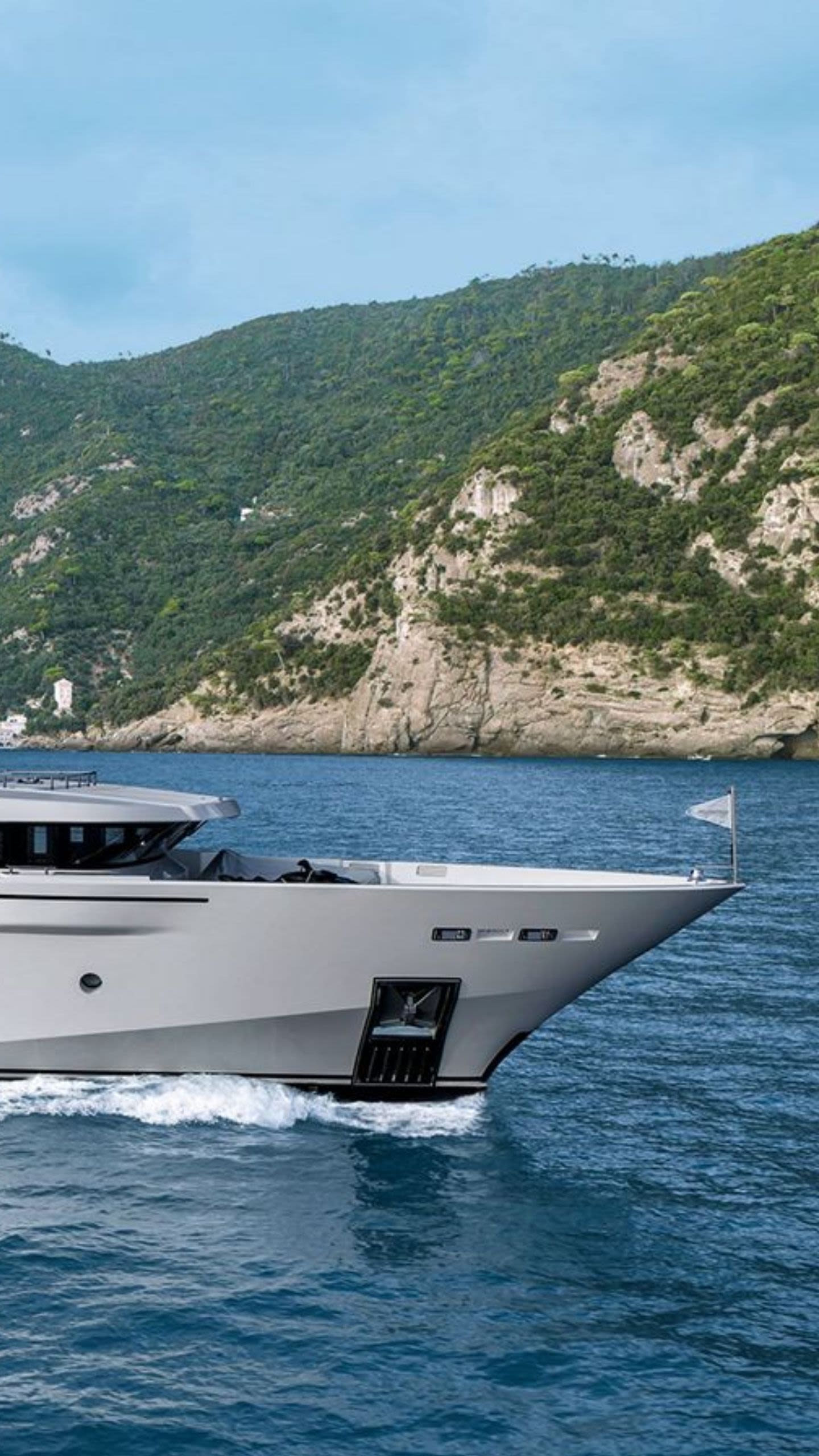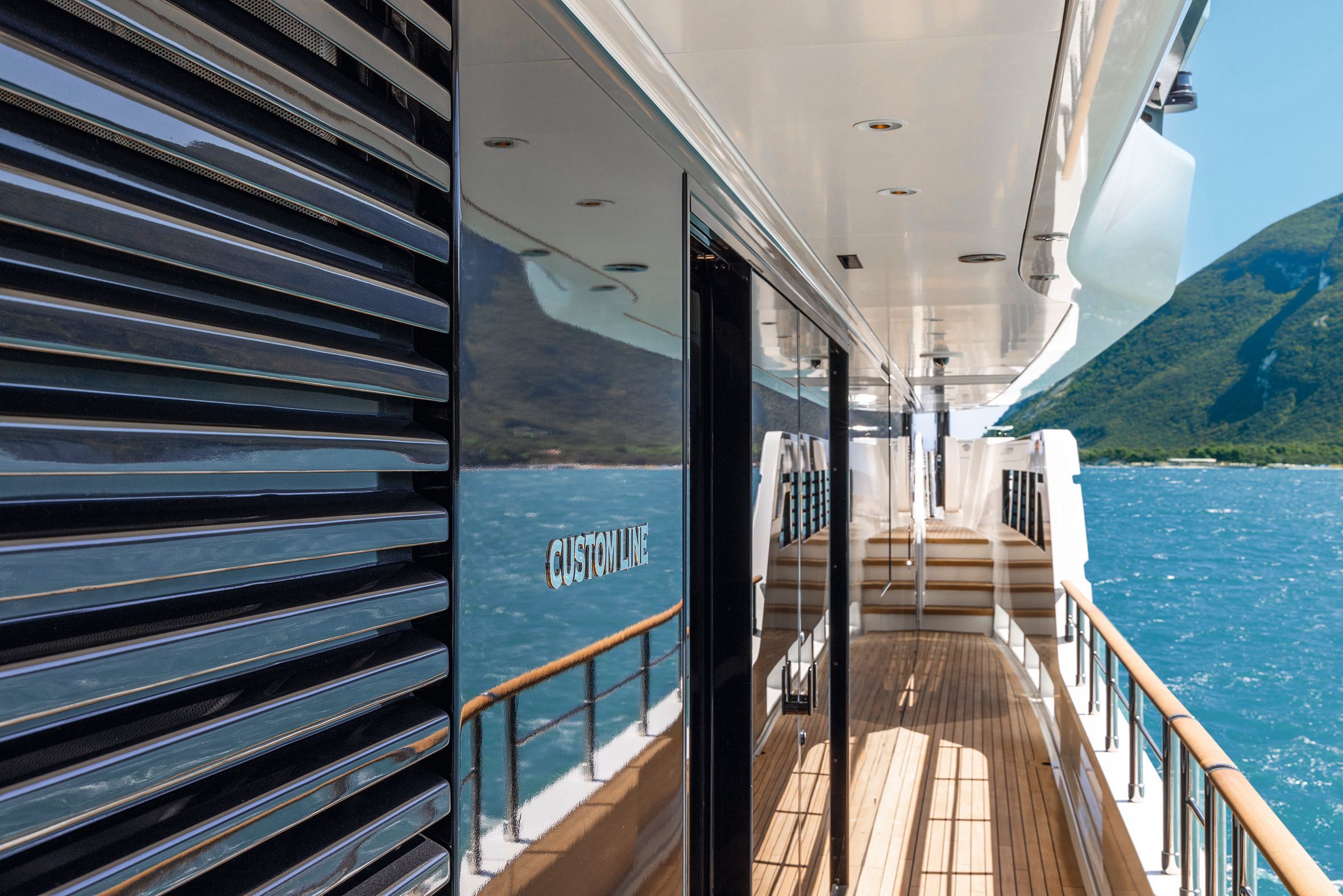WHY HAS CUSTOM LINE STARTED BUILDING IN ALUMINIUM?

Following the launch of Custom Line’s first all-aluminium yacht, BOAT sits down with Giordano Pellacani, sales and marketing director of custom business at Ferretti Group, to learn about what sparked the decision to move to metal.
Ferretti Group brand Custom Line has long been celebrated for its expertise in building GRP yachts in the 30-42-metre, sub-500GT category, especially the crowd-favourite Navetta line.
But the shipyard surprised the industry back in 2022 with the announcement of a 50-metre project built entirely in aluminium alloy. Fast forward to August 2024, and the first hull of the Custom Line 50 debuted at the Monaco Yacht Show, with a second hull already sold and set for delivery in 2026.
While the Custom Line 50 marks the brand’s first step into aluminium construction, it’s not a first for the Ferretti Group. “The Custom Line 50 is being built at the Ferretti Group Superyacht Yard in Ancona, where we also produce CRN, Riva and Pershing superyachts,” explains Pellacani.
“CRN has a rich history of constructing full-aluminium yachts, and we’re using that knowledge, capability and cutting-edge facilities to build the Custom Line 50 and meet the demands of Custom Line’s increasingly sophisticated clientele.”



Pellacani explains that the decision to move to metal comes down to its unique advantages, despite the higher cost compared to GRP. Aluminium’s lighter weight allows for a step up in terms of lifestyle features on board, particularly on a larger model like this one.
While the smaller Custom Line Navetta models, such as the Custom Line Navetta 40 and 42, sit below the 400GT threshold, the Custom Line 50 falls within the sub-500GT category, meaning owners gain access to enhanced regulations, classifications and captain licence.
“The sub-500GT, 50-metre range is very popular, so aluminium allows us to maximise the onboard features as much as possible in this category,” says Pellacani.
“One of our main goals was to target the American market,” he continues. “The lightness of aluminium allows us to include features that wouldn’t be possible with fibreglass. For example, we’ve achieved a low, Bahamas-friendly 2.2-metre draught, a forward-facing master suite that spans the full 9.6-metre beam and a private owner’s terrace on the upper deck. These are rare features for a yacht of this size.”

Pellacani explains that the decision to move to metal comes down to its unique advantages, despite the higher cost compared to GRP. Aluminium’s lighter weight allows for a step up in terms of lifestyle features on board, particularly on a larger model like this one.
While the smaller Custom Line Navetta models, such as the Custom Line Navetta 40 and 42, sit below the 400GT threshold, the Custom Line 50 falls within the sub-500GT category, meaning owners gain access to enhanced regulations, classifications and captain licence.
“The sub-500GT, 50-metre range is very popular, so aluminium allows us to maximise the onboard features as much as possible in this category,” says Pellacani.

“One of our main goals was to target the American market,” he continues. “The lightness of aluminium allows us to include features that wouldn’t be possible with fibreglass. For example, we’ve achieved a low, Bahamas-friendly 2.2-metre draught, a forward-facing master suite that spans the full 9.6-metre beam and a private owner’s terrace on the upper deck. These are rare features for a yacht of this size.”

Aluminium also enables the shipyard to incorporate the amount of glass windows that the client wanted, creating 180-degree panoramic views in the owner’s suite and the main saloon.
Quality over quantity is an ethos that resonates deeply with Custom Line. The focus isn’t on churning out as many hulls as possible but on building high-quality, fully customised yachts that cater to a diverse range of client needs.
“This approach not only ensures exceptional craftsmanship but also tends to result in higher resale values for the yachts,” says Pellacani.
"This yacht is designed for a sophisticated clientele - owners who truly understand yachting"

The Custom Line 50 is no exception to the yard’s commitment to customisation. “This yacht is designed for a sophisticated clientele - owners who truly understand yachting,” shares Pellacani. For this project, the shipyard enlisted long-time design collaborators Filippo Salvetti for the exterior and Milan-based ACPV Architects for the interior.
“The interior must reflect the owner’s lifestyle, so we allow for extensive customisation,” Pellacani notes. “Thanks to the aluminium hull, we can even adapt certain layout elements if planned in advance. It’s all about tailoring the yacht to make it unique to the owner.”



This approach proved a perfect match for the owner. “ACPV Architects had already worked with the owner on real estate projects, so the collaboration was a no brainer,” Pellacani adds. “The studio’s ability to blend modern and classic elements beautifully aligned with the owner’s vision. Custom Line might not be the most modern looking on the market, but it’s undeniably timeless.”
The lightweight nature of aluminium brings significant advantages to the Custom Line 50’s displacement hull. It reduces fuel consumption by 10-15 per cent, making the yacht more eco-friendly and cost-effective to run. Additionally, this efficiency optimises the cruising speed of 15 knots, offering a range increase of at least 10 per cent.

This approach proved a perfect match for the owner. “ACPV Architects had already worked with the owner on real estate projects, so the collaboration was a no brainer,” Pellacani adds. “The studio’s ability to blend modern and classic elements beautifully aligned with the owner’s vision. Custom Line might not be the most modern looking on the market, but it’s undeniably timeless.”

The lightweight nature of aluminium brings significant advantages to the Custom Line 50’s displacement hull. It reduces fuel consumption by 10-15 per cent, making the yacht more eco-friendly and cost-effective to run. Additionally, this efficiency optimises the cruising speed of 15 knots, offering a range increase of at least 10 per cent.

For more information on the Custom Line 50, contact the shipyard team today.

Sponsored content created for Ferretti Group







